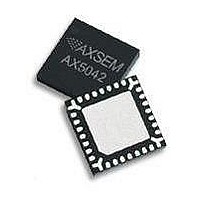AX5043-QFN28-TU AXSEM, AX5043-QFN28-TU Datasheet - Page 29

AX5043-QFN28-TU
Manufacturer Part Number
AX5043-QFN28-TU
Description
RF Transceiver Narrow-Band-IC
Manufacturer
AXSEM
Datasheet
1.AX5043-QFN28-TU.pdf
(60 pages)
Specifications of AX5043-QFN28-TU
Number Of Receivers
1
Number Of Transmitters
1
Wireless Frequency
70 MHz to 1050 MHz
Interface Type
SPI
Output Power
18 dBm to 22 dBm
Operating Supply Voltage
1.8 V to 3.6 V
Maximum Operating Temperature
+ 85 C
Maximum Supply Current
60 mA
Minimum Operating Temperature
- 40 C
Modulation
ASK, FSK
Lead Free Status / RoHS Status
Lead free / RoHS Compliant
5.10. Encoder
The encoder is located between the Framing Unit, the Demodulator and the Modulator. It can
optionally transform the bit-stream in the following ways:
The encoder is programmed using the register
the AXSEM
5.11. Framing and FIFO
Most radio systems today group data into packets. The framing unit is responsible for converting
these packets into a bit-stream suitable for the modulator, and to extract packets from the
continuous bit-stream arriving from the demodulator.
The Framing unit supports two different modes:
The micro-controller communicates with the framing unit through a 256 byte FIFO. Data in the FIFO
is organized in Chunks. The chunk header encodes the length and what data is contained in the
payload. Chunks may contain packet data, but also RSSI, Frequency offset, Timestamps, etc.
The
mode is selected.
The FIFO can be operated in polled or interrupt driven modes. In polled mode, the micro-controller
must periodically read the FIFO status register or the FIFO count register to determine whether the
FIFO needs servicing.
In interrupt mode EMPTY, NOT EMPTY, FULL, NOT FULL and programmable level interrupts are
provided. The
is level triggered, active high. Interrupts are acknowledged by removing the cause for the interrupt,
i.e. by emptying or filling the FIFO.
Version 0.2
•
•
•
•
•
•
AX5043
It can invert the bit stream.
It can perform differential encoding. This means that a zero is transmitted as no change in
the level, and a one is transmitted as a change in the level. Differential encoding is useful
for PSK, because PSK transmissions can be received as either transmitted or inverted, due
to the uncertainty of the initial phase. Differential encoding / decoding removes this
uncertainty.
It can perform Manchester encoding. Manchester encoding ensures that the modulation
has no DC content and enough transitions (changes from 0 to 1 and from 1 to 0) for the
demodulator bit timing recovery to function correctly, but does so at a doubling of the data
rate.
It can perform spectral shaping (also know as whitening). Spectral shaping removes DC
content of the bit stream, ensures transitions for the demodulator bit timing recovery, and
makes sure that the transmitted spectrum does not have discrete lines even if the
transmitted data is cyclic. It does so without adding additional bits, i.e. without changing
the data rate. Spectral Shaping uses a self-synchronizing feedback shift register.
Packet modes
Raw modes
AX5043
contains one FIFO. Its direction is switched depending on whether transmit or receive
AX5043
configuration software.
signals interrupts by asserting (driving high) its IRQ line. The interrupt line
Preliminary
ENCODING
. To calculate the optimal settings use
Circuit Description
Datasheet AX5043
29















